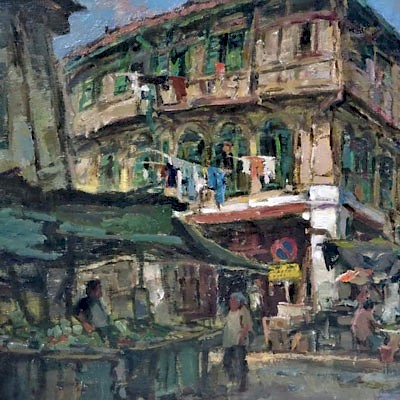Besler (1561-1629) Botanical Portfolio Page 1600's
About Seller
522 South Pineapple Avenue
Sarasota, FL 34236
United States
Sarasota Estate Auction specializes in a wide variety of furniture, antiques, fine art, lighting, sculptures, and collectibles. Andrew Ford, owner and operator of the company, has a passion for finding the best pieces of art and antiques and sharing those finds with the Gulf Coast of Florida.
Two ways to bid:
- Leave a max absentee bid and the platform will bid on your behalf up to your maximum bid during the live auction.
- Bid live during the auction and your bids will be submitted real-time to the auctioneer.
Bid Increments
| Price | Bid Increment |
|---|---|
| $0 | $10 |
| $100 | $25 |
| $250 | $50 |
| $1,000 | $100 |
| $2,500 | $250 |
| $7,500 | $500 |
| $20,000 | $1,000 |
| $50,000 | $2,500 |
| $100,000 | $5,000 |
| $250,000 | $10,000 |
About Auction
Jul 28, 2019
Sarasota Estate Auction sarasotaestateauction@gmail.com
- Lot Description
This lot consists of a portfolio page from Hortus Eystettensis, a botanical book produced by Basilius Besler in the 1600’s. Besler was an apothecary and botanist in this time period and is best known for compiling this book, which is one of the most important botanical books ever recorded. Christie’s has called it the greatest flower book in the world. The book is a codex - a florilegium - a gathering of all the flowers grown in the gardens of the Prince of Eichstatt in Bavaria. There were eight gardens that surrounded the castle of the Prince, and he wanted to record the diversity and beauty of all the gardens. In 1611 the Prince employed Besler to create this record, and the result was one of the finest treasures of botanical literature ever produced. Besler is often cited as the author of the Hortus Eystettensis, but he was really the person who guided the compilation and publication of the book. He was originally employed as an apothecary and botanist at a time when herbal medicine was very important, but he didn’t write any botanical descriptions for the book. He engaged artists, engravers, printers and colorists to create the masterpiece. The artists created color drawings on site or from specimens - Besler chose to draw the rare and more beautiful plants over indigenous species - and they were drawn when the plants were in full-bloom; most of the plants in the book were depicted in actual or near-life size. A team of engravers then translated the drawings into black and white copperplate engravings that could be used for reproduction. The engravers were highly skilled and the results were copper plates of high quality. In some of the books, the black and white pictures made from the engravings would be hand-colored, just like the portfolio page here. The coloring was done in a transparent watercolor wash that allowed the lines to show through and maintain the volume and dimension of the plants. Besler worked on the book for 16 years, and subsequently it became an important historical document, and while he never did any of the drawings himself, he was very important to the development of botanical art. In the end, the book is a magnificent pictorial document, in a class of its own. The book is also considered the first botanical book portraying plants as objects of beauty, not just a book about the medicinal uses of plants and herbs. The complete book has 366 plates, which pretty much correspond to the number of days in a year, and the contents were arranged according to the seasons. The book was printed on the largest paper available at the time, each page measuring 22 by 18 inches. The work was first published in 1613 and the first edition had two versions. One had 367 copper engravings with an average of three plants per page. A small number of “princely gift” editions were printed without text, they were printed only on one side and hand colored on high quality paper. The other was a black and white version with text. The text was in Latin, and this version was intended as a reference book for apothecaries and botanists. It was produced in an edition of 300, but was so expensive that it took four years for all the copies to sell. One of the problems with this edition was the words used to describe the plants were printed on the back of the portfolio page, and the words showed through on the front side of the page. The problem was remedied in different ways in subsequent editions. The second edition was printed in 1640 and the back of the folio print was left blank. The third edition was printed in 1713, and the text was once again printed on the back side of the print. In 2016, a deluxe edition of Hortus Eystettensis from 1613 sold at Christie’s for over $2.5 million dollars. The book is sometimes called Besler's Florilegium, and the portfolio page offered here depicts three flowers: a Pseudosycomorus, a Millefolium Florirubis, and a Millefolium Florialbo. The flowers are hand-colored and the text on the back is in Latin. The text also describes the plants on the previous portfolio page and includes the name of the engravers and the person who wrote the description for that page. (If you look at the picture of the book at the University of Liege, you can see the portfolio page depicting the flowers was on the left side of the book and the text was on the right, not the back, so any text that appeared on the back of the portfolio page actually described the plants on the previous page. Currently only a handful of the original books are known to exist. Four are in Special Collections: Cornell University, the University of Victoria, the University of Liege in Belgium, and Wurttembergische Library in Stuttgart, and the rest appear to be in private hands. In 1994, an additional 329 plates were discovered in the archives of the Albertina Museum in Vienna. The consignor acquired the portfolio page at the antiquarian book fair in New York in 2000. There's light foxing at the bottom of the portfolio page and, other than that, no apparent condition issues. The frame is 32 1/2 x 28 1/8 inches and the sight size is 21 1/2 x 17 1/2 inches.
- Shipping Info
-
We offer several options for shipping. You can pick your own shipper or we can provide you with a list of shippers to pick from. Please contact Nick Dussault at The UPS Store if you are looking for an advance quote. He can be reached at 941-358-7022 or email him at store4074@theupsstore.com If someone picks up something on your behalf, please call the auction house ahead of time to make arrangements for that kind of pickup. We recommend getting insurance on valuable purchases, but that?s your choice as well. Once you pick a shipper, the shipper will provide you with a quote for how much the shipping will cost, and if there is any damage to an item after the shipper picks it up, please contact the shipper to discuss the damage. We assume no responsibility for damage to an item once a shipper picks it up. Failure to pay for your purchases or shipping through a third party may result in forfeiture of the lot you purchased. Purchased items not picked up from our auction house or do not have shipping arrangements made within 15 business days of the auction will be assessed a storage fee of $5.00 per day.
-
- Payment & Auction Policies
-
Available payment options
We accept all major credit cards, wire transfers, money orders, checks and PayPal. Please give us a call at (941) 359-8700 or email us at SarasotaEstateAuction@gmail.com to take care of your payments.
-
- Buyer's Premium



 EUR
EUR CAD
CAD AUD
AUD GBP
GBP MXN
MXN HKD
HKD CNY
CNY MYR
MYR SEK
SEK SGD
SGD CHF
CHF THB
THB
















